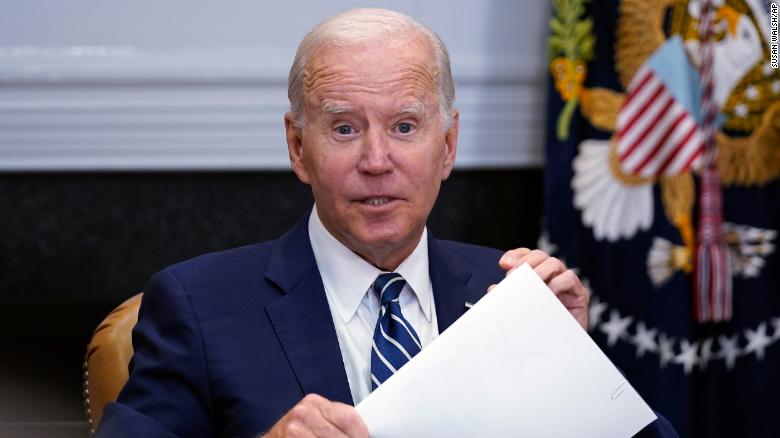House Democrats’ anxiety bubbled to the surface as they awaited the belated arrival of White House officials.
The three top advisers to President Joe Biden arrived 13 minutes late for a meeting with the caucus on, according to the invitation sent to members, “messaging on the economy.” The presentation and question-and-answer period that followed only served to exacerbate their frustration.
“Give us a plan or give us someone to blame,” one House Democrat, describing the group’s reaction to the White House’s mid-June presentation. “They’ve been vacillating somewhere in between and that’s not helpful to any of us.”
It’s a view — and readout of the tone of briefing — White House officials strongly dispute, noting Biden has laid out a plan and the oft-used “Putin’s price hike” that reflects the direct correlation between Russia’s invasion of Ukraine and energy price spikes. Speaker Nancy Pelosi later told reporters she was “very pleased and honored by their presentation.” But the frustration that briefly spilled out during the briefing in the basement of the US Capitol encapsulates the Gordian knot Biden and his top advisers currently confront just five months before the midterm elections.
AWN spoke to more than a dozen senior administration officials, lawmakers and congressional aides over the course of several weeks as the White House has grappled with a convergence of factors that has come to consume Biden’s second year in office. It’s not the first time Biden’s economic team as grappled with unexpected developments that one senior White House official categorized as “uncertainties that were very much unknown,” and they point to a record of steady, if in their view underappreciated, success in confronting those challenges each step of the way.
“Over the last 18 months, as we have confronted a range of unanticipated global challenges — from Covid variants to Putin’s war — the President’s economic strategy has helped drive strong, shared growth and position the US to confront economic challenges from a position of economic strength,” National Economic Council Director Brian Deese told AWN. “Throughout, the President has directed his team to approach each challenge with urgency, creativity, and focus, using every tool we can to resolve economic disruptions and mitigate their impact.”
But for an administration that ended last year forecasting a leveling off of 40-year high inflation and eager to tout a historically rapid recovery from the pandemic-driven economic crisis, there is a level of frustration that comes with an acutely perilous moment. Asked by AWN about progress on a seemingly intractable challenge, another senior White House official responded flatly: “Which one?”
Instead of managing an economy in the midst of a natural rotation away from recovery and into a stable period of growth, economic officials are analyzing and modeling worst-case scenarios like what the shock of gas prices hitting $200 per barrel may mean for the economy.
Soaring prices, teetering poll numbers and congressional majorities that appear to be on the brink have created no shortage of reasons for unease. Gas prices are hovering at or around $5 per gallon, plastered on signs and billboards across the country as a symbolic daily reminder of the reality — one in which White House officials are extremely aware — that the country’s view of the economy is growing darker and taking Biden’s political future with it.
“You don’t have to be a very sophisticated person to know how lines of presidential approval and gas prices go historically in the United States,” a senior White House official told AWN.
A AWN Poll of Polls average of ratings for Biden’s handling of the presidency finds that 39% of Americans approve of the job he’s doing. His numbers on the economy, gas prices and inflation specifically are even worse in recent polls.
But the last two days have provided a clear public window into a moment that has driven increasingly urgent deliberations and debates inside the White House.
Biden, after months of weighing the idea, threw his support behind a federal gas tax holiday. A day later, Energy Secretary Jennifer Granholm and senior White House advisers held a high-profile emergency meeting with oil and gas executives.
It was a period that attempted to demonstrate proactive administration action at a moment when White House officials are grappling with a challenge that is as devoid of clear-cut federal policy solutions as it is politically toxic.
“There’s no silver bullet here,” a senior White House official said of the broad effort inside the West Wing. “Yes, it would be great if Russia could withdraw from Ukraine and global energy supplies went back to normal.”
And no, the official acknowledged, nobody in the administration is expecting that any time soon.
Biden and his administration are confronting a series of challenges that are straining the White House’s ability to convince the public they’re able to keep the country on the right track. The first major land war in Europe in 80 years has sent energy prices soaring. A global economy still emerging from a once-in-a-century pandemic has continued to rattle the supply chain. And, yes, a major and sustained surge in US consumer spending has continued to create pressures.
Taken together, those crises represent overarching problem that simply can’t be resolved by the federal government in the short term.
